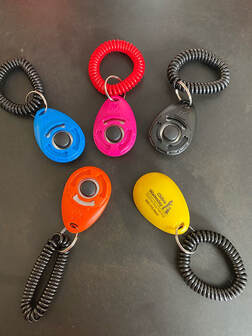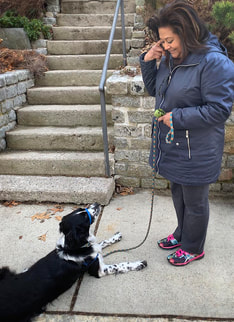Your dog, your cues - gaining maximum effectiveness Marker training is a scientific based teaching method that communicates to a dog that they have done the correct behavior desired by the trainer/handler and will therefore be rewarded. It is also known as positive reinforcement dog training. In marker training you can either use a verbal marker such as “Yes”, “Click”, “Bravo”, “Nice” or you can use a device called a “Clicker” which is basically a toy-like mechanical devise with a button which when pressed will make a sound. So how does marker training really work?To teach your dog that your chosen marker has meaning you will need to “charge” or “load” the verbal marker or the clicker. This is where you will have about 10 rewards to hand, say your verbal marker “Yes” and half a second later reward your dog. Similarly, if using a clicker, you will click and half a second later reward your dog. The timing and order of doing this is very important so that the dog is focused on hearing that marker to gain the reward and not just concentrated on the reward. To then translate this into training the sequence will be, ask for the behavior for example a “sit”, when the dog goes into a sit you either say “yes” and reward your dog or if using a clicker, click and reward your dog. Therefore, the sequence is, behavior = marker = reward. A question I get asked a lot is “do I have to use a clicker or marker for the rest of the dog’s life”? The answer to this is “no”. The more you work with your dog and the more fluid they become at doing the behaviors you have taught them this is where you will begin to give variable rewards, that is, not rewarding them for every single sit that they perform and instead reward them for every third and then sixth one and continue to do the same with all cues. After that you can then begin to phase out the rewards. The only cue that I suggest to clients that they always reward for is Recall. That is when you call your dog back to you and they listen, especially when you are in an environment with a lot of distraction, for example a park, but your dog has chosen to come back to you. That, in my opinion deserves a lot of praise and rewards to keep your Recall solid. What if my dog doesn't do what I am asking? This is where a “no reward marker” will come into play. A no reward marker is used when your dog has not offered the behavior that you are asking for. It is a verbal signal such as “no” or “uh oh” or “Oops” that you will say in a neutral tone to communicate to your dog that they have not offered the behavior you want and need to try again. I advise clients to use no reward markers sparingly in training as if you are teaching a dog something and they are trying to learn but are not quite getting it right, too many no reward markers can begin to stress the dog and what you do not want to associate in your dog’s mind is that training is stressful, quite the opposite. It is important to note here that a no reward marker is NOT a physical correction to the dog it is simply a way to communicate with your dog verbally that they have made a mistake and will have to work a little harder to get that reward. In essence marker training, whether you are using a verbal marker, or a clicker teaches your dog to problem solve. The key to training is to find the thing that really motivates your dog which may be its food, dog treats, a special toy and use that to reward them when they offer behaviors you are looking for. Summing it all upAs with learning any new skill the key to dog training is time, patience, consistency and repetition. Remember, training is where you begin the journey of building that special bond with your dog, teaching them cues that later you will implement into your life with them so that they will understand what it is you expect from them. Our human world is very complex for our K9 members of the family but through training you will teach them boundaries to keep them safe, have fun with them and by using this proven, scientific based method of training you reinforce the behaviors you want quickly and make the process of learning for your dog and for you enjoyable!
0 Comments
|
AuthorWrite something about yourself. No need to be fancy, just an overview. Archives
June 2024
Categories |

 RSS Feed
RSS Feed